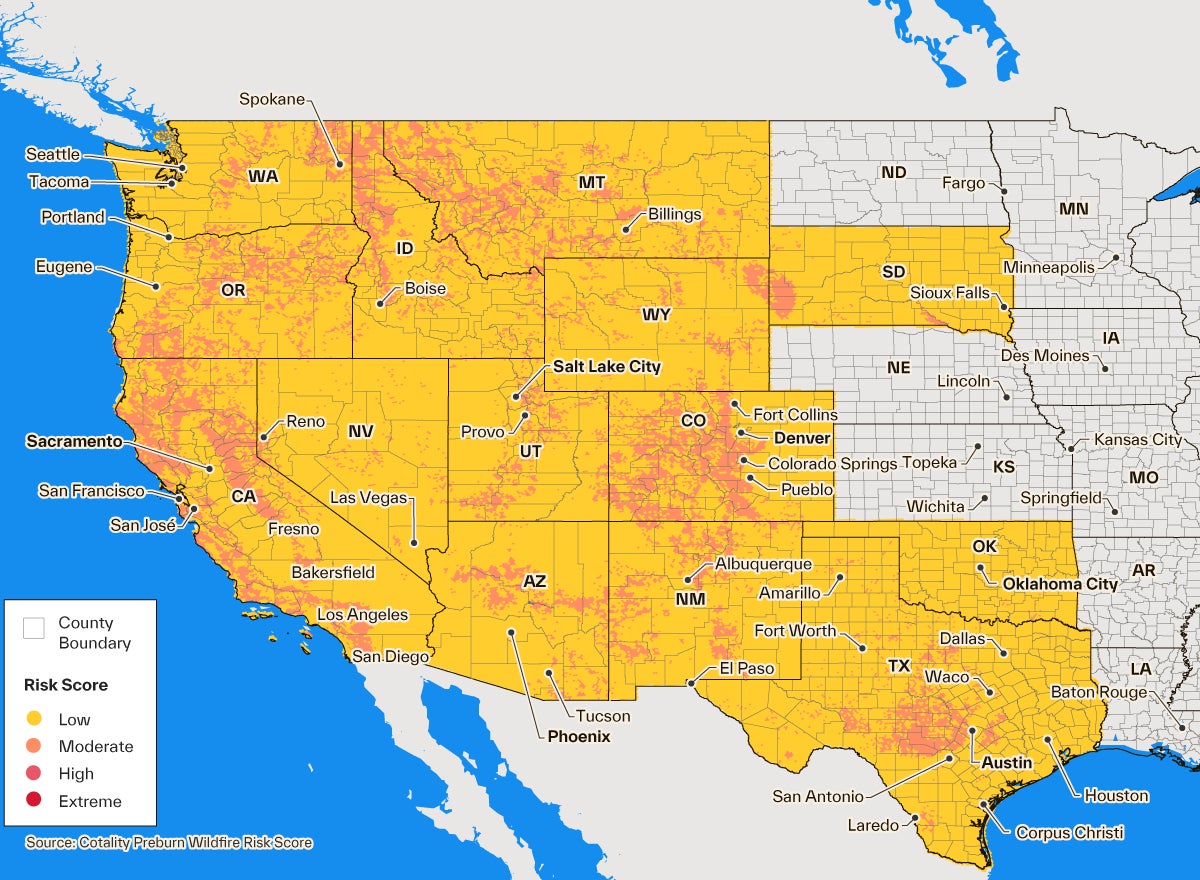Press Release
New Cotality Wildfire Risk Report finds more than 2.6 million homes are exposed to moderate or greater wildfire risk
IRVINE, Calif., August 19, 2025 – Wildfires, once confined to a so-called “wildfire season” are now an ever-present threat, according to a new report published today by Cotality™,a leading global property data and analytics-driven solutions provider. The 2025 Cotality Wildfire Risk Report: Priced Out & Burned Out, finds that more than 2.6 million homes in the Western United States, representing a combined reconstruction cost value of $1.3 trillion, face moderate or greater risk of wildfires, with more than one million of those homes facing very high risk.
Residential properties and their wildfire risk score throughout the western United States
Data source: Cotality, 2025
Spread across 14 states in the Western United States, nearly half of the homes are in California (1.3 million), with Colorado (319,000), Texas (243,000), Oregon (128,000) and Arizona (124,000) rounding out the top five states with the largest number of homes at risk. These states contain a high number of homes in the Wildland-Urban Interface (WUI) where there is elevated risk due to their proximity to forested or undeveloped areas.
Homes per state with moderate or higher risk and respective reconstruction cost value
Data source: Cotality, 2025
“Wildfires are complex, fast-moving, dangerous—and a growing threat to homes and communities. Understanding the level of risk will help equip homeowners and insurers to take preventative action that can save properties and lives,” said Tom Larsen, Cotality’s AVP of Product Marketing for Insurance Solutions. “There are many contributing factors to the increasing threat of wildfires, including where and how we build. Building with wildfires in mind and introducing mitigation measures for where we have already built is one of the critical conversations we need to be having right now.”
California is home to eight of the top 15 metro areas with the most homes at moderate or greater wildfire risk – but wildfire threat isn’t just a problem in the Golden State. Metros like Austin, Denver, and Colorado Springs, are also facing elevating risks. Wildfire behavior is shifting due to multiple factors, including fuel build up from decades of fire suppression, expanding development into the WUI driven by population growth, and longer, drier seasons.
Homes with moderate or higher risk by metropolitan area and their respective reconstruction cost value
Data source: Cotality, 2025
The report also explores the complexities of wildfires by analyzing the Palisades and Eaton fires that occurred in January2025 and resulted in devastating conflagration events. Though both Los Angeles wildfires ignited as conventional wildfires, they transitioned into wildfire-induced conflagration once the fuel shifted from vegetation to the built environment of homes and businesses. The conflagration shift dramatically alters how fires spread and magnifies potential destruction that can occur. Since 2020, wildfire-induced conflagrations have destroyed more than 26,000 structures across the country.
To read the full report, visit the Cotality website. To learn more about Cotality’s wildfire science capabilities, and for a deeper dive on the recent conflagration analysis, join Cotality Insurance Solutions for a webinar on August 26 at 12 p.m. ET.
###
About Cotality
Cotality accelerates data, insights, and workflows across the property ecosystem to enable industry professionals to surpass their ambitions and impact society. With billions of data signals across the life cycle of a property, we unearth hidden risks and transformative opportunities for agents, lenders, insurers, governments, and innovators. Get to know us at cotality.com.
Media Contacts
Carly Owens
Cotality







